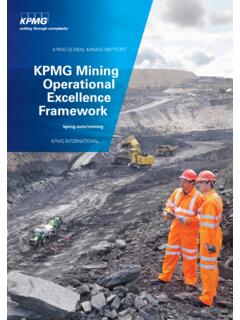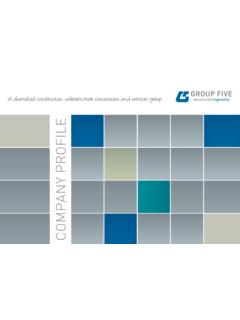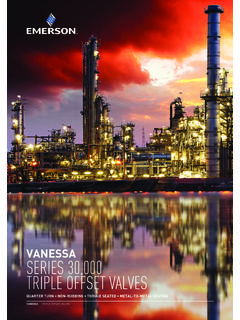Transcription of Future of mining with AI: Building the first steps towards ...
1 Future of mining with AI: Building the first steps towards an insight driven organizationIntroductionWith a majority of mines still using legacy technology and facing the growing need to drive operations deeper underground, easily attainable cost and productivity savings are getting harder to obtain. Moreover, productivity in mining operations world wide continues to decline despite continuous improvements to operations and even after adjusting for declining ore grades. On top of that, the industry continues to face:yyVolatile commodity prices which continues to squeeze cash flow and put pressure on profitability;yyChanging the nature of work where changing demographics, the nature of jobs and perceptions of mining as a career choice are heightening the need to re envision talent management;yyMaturity of existing mines leading to lower ore grades and longer haul distances.
2 YyInnovation barriers where mining companies tend to be risk averse and have an inclination to distrust collaboration due to IP and competition of contentsIntroduction 1 Making the case why AI and why now 4 Building the case challenges in AI implementation 6 Becoming an insight driven enterprise 8 Future of mining is here 11 About Deloitte/NORCAT partnership 12 Future of mining with AI | Introduction1In planning for the Future of operations, mining leaders seeking to turn challenges into opportunities are increasingly looking to the suite of advanced technologies related to artificial intelligence (AI), such as machine learning and natural language processing that help drive deeper insights, and deep learning neural networks that can significantly enhance image and speech recognition.
3 While there are no single technology solutions to industry challenges, when effectively integrated into workflows traditionally requiring human intelligence, AI related technologies are now enhancing the organization s capacity to accomplish tasks, make decisions, create engaging interactions, and generate stronger business third report in the Deloitte NORCAT series on key trends in the mining industry examines where AI and related applications are bringing tangible benefits and already making pathfinding differences to mining operations. Drawing on a series of interviews Deloitte and NORCAT conducted recently with technology companies Building AI solutions for mining companies, it explains how and why these mining companies have used AI based applications, while also identifying key benefits and considerations for optimizing investment in these technologies going forward.
4 It verifies that success in the mining industry increasingly depends on changing the way it does business starting with adapting to changing skills for frontline workers, and better understanding how technology can ensure resources are used optimally, and that operations become safer and more productive. It underscores that getting there begins by addressing fundamental questions:yy Why should mining companies adopt AI applications?yy Which key challenges arise when deploying AI within the mining industry?yy How can mining companies prepare to adopt AI and take the first steps ? Navigating the complexities of any technology implementation can be challenging, however, and key partnerships are increasingly critical to ensuring technology enhances the company s core values and capacities, while remaining flexible and cost effective.
5 Let s see how mining companies are already using AI related technologies to make a what we mean by AIACTIONABLE INSIGHTS Result of extensive data analytics where information gives enough insights to drive decision makingANALYTICS The use of data and algorithms to improve decision making by generating insightsCOGNITIVE Component of AI containing a human like layer of interaction between people, underlying data and technologies that form AIMACHINE LEARNING Algorithms that improve over time through exposure to more dataDEEP LEARNING Subset of Machine Learning that uses neural networks1 with massive amounts of data to learn 1. Neural network: collection of simple processors connected together in layers.
6 Each processor can only perform a very straightforward mathematical task, but a large network of them has much greater capabilities and can do many things which one on its own can t. To learn more about the AI concepts in the image, refer to the article: Seizing the real AI opportunity, Deloitte, 2018. Available on Actionableinsights Deeplearning Future of mining with AI | Introduction23 Making the case why AI and why nowWhile artificial intelligence is still an emerging suite of advanced and practical technologies, AI is enabling mining companies to become insight driven enterprises that utilize data to derive key worked with companies that are developing AI applications for the mining industry, NORCAT recently teamed up with Deloitte to conduct a series of interviews with these companies to better understand how and why they used AI based technology, to identify the key benefits artificial intelligence technologies afford, and to make the case for greater adoption within the industry.
7 The stories told by all companies interviewed depict active products, solutions and associated benefits, with the following companies highlighted to further illustrate their DECISIONS WITH GREATER ACCURACY With mine operations requiring ever larger amounts of data processing, the majority of which is still collected manually or by visual inspection, using machine learning to deliver value by instantly collecting data and deriving on site insightful decision factors has the potential to vastly streamline the workflow while reducing error in some cases by orders of magnitude. RockMass Technologies, for example, has deployed the latest generation of sensors to capture real time data to identify potential failure planes on rock surfaces, using handheld hardware to analyze rock surfaces and providing the data to the user within minutes.
8 This is done with software that analyzes data 18 times faster than current manual methods, the result is a consistent and radically efficient method for making accurate and quick assessment of potential HEALTH AND SAFETY AI supports better and faster decision making, which is critical to improving health and safety conditions for frontline mineworkers, reducing their exposure to dangerous situations, and accelerating the shift in mining to be more process, rather than people oriented . Leveraging AI capabilities is at the core of ThoroughTec s simulator based training platform, where wearable sensors continuously monitor worker behavior, generating data that is then automatically analyzed to spot problematic behavioural trends and recommend highly focused remedial training in a simulator based environment.
9 This enables mine managers to proactively respond to latent or emergent gaps in operator capabilities, optimising training interventions to best match individual worker needs and ultimately raising the standards of operator performance across the entire EFFICIENCY THROUGH ERROR ELIMINATION Quickly deriving patterns from large amounts of data can drive efficiency by increasing the consistency and quality of work that typically is subject to human error. Ionic Engineering s use of machine learning to vastly enhance image recognition used in identifying the copper grades reduces to negligible the error rate compared to employees doing the work. By training the machine in parallel with a person specifically, by using neural networks to learn characteristics the operator is looking for operation time and product quality is ultimately improved, thereby upping the potential to reduce ENVIRONMENTAL FOOTPRINT Embedding AI technology in pre existing systems is helping the mining industry reduce energy demand and decrease its environmental footprint.
10 Ventilation presents the largest energy cost in an underground mine. Drawing on more than six years of data, Shyft Inc. is using machine learning to forecast energy peaks. AI enhanced automatic adjustment of ventilation systems using integrated process control assists with significant energy cost , no technology ever has or will be a magic bullet for industry at large or in any specific operational context. At the same time, the mining industry is learning that AI related technologies can help frontline workers make better decisions quicker, while reducing human error, environmental footprints and the need for human intervention in potentially dangerous and using AI related technologies, however, brings significant challenges, and mining companies need first and foremost to understand the key constraints and barriers they re apt to face when deploying AI within their this technology allowed our team to process day to day data 18 times faster than what is typically done in the field.

















